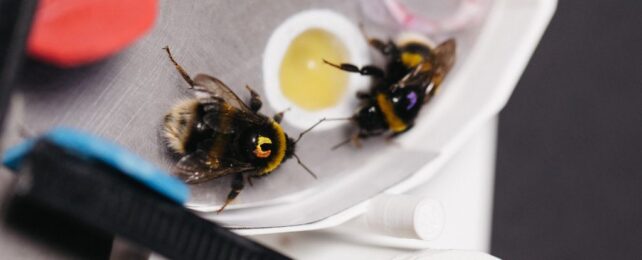The humble bumblebee is proof that brain size isn't everything.
This little insect with its wee, seed-sized brain has shown a level of collective intelligence in experiments that scientists thought was wholly unique to humans.
When trained in the lab to open a two-step puzzle box, bumblebees of the species Bombus terrestris could teach the solution to another bee that had never seen the box before.
This naive bee would not have solved the puzzle on its own. To teach the 'demonstrator' bees the non-intuitive solution in the first place, researchers had to show them what to do and offer them a reward after the first step to keep them motivated.
"This finding challenges a common opinion in the field: that the capacity to socially learn behaviors that cannot be innovated through individual trial and error is unique to humans," write the team of researchers based in the United Kingdom and United States.
Humans have a long history of 'moving the goalposts' on what sets our species apart from all others.
Once, it was thought that humans were the only animals with culture. But 'viral' songs among sparrows, the evolving dialects and traditions of whales, the regional hunting strategies of orcas, and the learned tool tricks of apes, crows, and dolphins, all suggest that socially transmitted behaviors are also present in animal societies, too.
Some of these cultural behaviors even show signs of refinement and improvement over time. Homing pigeons, for instance, learn from each other and adjust their culture's flight paths year on year.
An influential way to move the goalposts on human intelligence is to say that humans are unique from other animals because we can learn things from each other that we could not invent independently.
Think of the device you are reading this article on right now. No one human can invent all its parts and mechanics from scratch on their own and in one lifetime. It's taken decades of work and refinement to get to this advanced stage. Even the very act of reading is a skill that generations of humans have built upon little by little.

Obviously, no animal can put together an iPhone or read an article on animal intelligence. But at a basic level, bumblebees join chimpanzees in "cast[ing] serious doubt on this supposed human exceptionalism," writes Alex Thornton, an ecologist at the University of Exeter, in a review of the bumblebee research for Nature.
Chimpanzees have large brains and rich cultural lives, but the discovery among bumblebees, Thornton argues, is "all the more remarkable because it focuses not on humanity's primate cousins, but on… an animal with a brain that is barely 0.0005 percent of the size of a chimpanzee's."
Underestimated for decades, largely because of their size, bumblebees are finally getting their due.
Recent experiments in the lab show these bees can learn from each other, use tools, count to zero, and perform basic mathematical equations.
The collective intelligence of their hive mind is also not to be dismissed.
To test it, behavioral scientist Alice Bridges from Queen Mary University of London and colleagues housed colonies of bumblebees with a two-step puzzle for a total of 36 or 72 hours over 12 or 24 consecutive days, with no human help.
After all that time, the bees could not figure out how to get to the sugary reward. Bumblebees spend on average about 8 days foraging in their lifetimes, so it's as if they had up to a third of their lifetime foraging time to work on the puzzle.
In the image below, you can see the puzzle. The yellow circle contains a drop of sugar under a plastic lid. Bees can get to it by pushing the red tab, but only once the blue tab has been pushed out of the way.

It took a human to painstakingly show the bees the way, and this was only possible using an extra reward. But once one bee figured the puzzle out, they could teach others how to move the two tabs to retrieve a sugary treat.
A similar experiment on chimps was also published recently in Nature Human Behavior. Both the vertebrate and invertebrate case studies showed a sharing of ideas that were exceptionally hard to learn alone.
Of course, this behavior wasn't observed in the wild. It had to be taught to the bees and chimps first. But the findings leave open the possibility that if there were a rare, once-in-a-lifetime innovator in chimp or bee society – an Einstein among bees – their ideas might stick around in animal culture and be used for generations to come.
Bees' famous honey waggle dance, pointing out the distance, direction, and quality of sources of food, for instance, is a behavior that was once thought to be purely instinctive, but it now appears to be somewhat shaped by social influences.
In 2017, researchers also trained bumblebees to roll a ball into a goal for a reward. To score, the insects had to learn from each other and remedy their previous mistakes. And so they did.
The newest experiment, Thornton writes, "suggests that the ability to learn from others what cannot be learnt alone should now join tool use, episodic memory (the ability to recall specific past events) and intentional communication in the scrapheap" of explanations for human cognition and culture.
The study was published in Nature.
